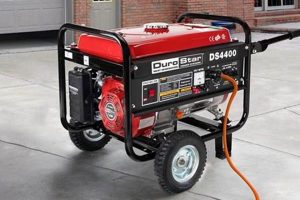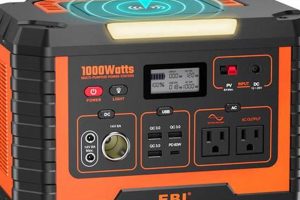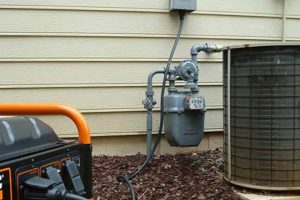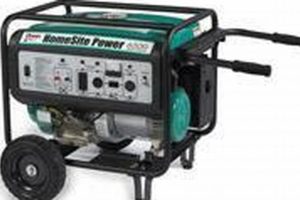Constructing an independent power supply using photovoltaic technology involves assembling several key components: solar panels to capture sunlight and convert it into electricity, a charge controller to regulate the energy flow to the battery, a battery bank for storing the generated power, and an inverter to transform the direct current (DC) electricity from the battery into alternating current (AC) usable by standard appliances. A typical example might involve connecting a series of 100-watt solar panels to a charge controller, which then feeds a deep-cycle battery bank. The inverter, connected to the battery bank, provides AC power for devices.
Off-grid power solutions offer significant advantages in various situations. They provide independence from the electrical grid, enabling functionality during power outages or in remote locations. Furthermore, utilizing solar energy contributes to environmental sustainability by reducing reliance on fossil fuels. Historically, creating independent power systems required complex engineering and expensive components. Advancements in photovoltaic technology, battery storage, and power electronics have made these systems more accessible and affordable.
The following sections detail the essential steps and considerations for assembling such a system, including selecting appropriate components, understanding power requirements, and ensuring safe and efficient operation.
Tips for Constructing a Portable Solar Generator
Careful planning and component selection are crucial for a successful build. The following tips offer guidance for creating an efficient and reliable portable solar power system.
Tip 1: Accurately Calculate Power Needs. Determine the wattage requirements of devices intended to be powered. This calculation informs appropriate solar panel and battery capacity choices.
Tip 2: Choose Suitable Solar Panels. Consider monocrystalline, polycrystalline, or thin-film panels based on efficiency, portability, and budget constraints. Monocrystalline panels offer higher efficiency but are more expensive.
Tip 3: Select an Appropriate Charge Controller. Match the charge controller to the voltage and amperage of the solar panels and battery. PWM (Pulse Width Modulation) controllers are generally less expensive, while MPPT (Maximum Power Point Tracking) controllers offer increased efficiency, especially in varying light conditions.
Tip 4: Opt for Deep-Cycle Batteries. Deep-cycle batteries are designed for repeated discharging and recharging, making them essential for energy storage in solar power systems. Consider AGM (Absorbent Glass Mat) or lithium-ion batteries for their longevity and performance.
Tip 5: Select the Right Inverter. Choose a pure sine wave inverter to ensure compatibility with sensitive electronics. The inverter’s wattage should exceed the combined wattage of the devices it will power.
Tip 6: Prioritize Safety. Use appropriately sized wiring and fuses to prevent overheating and fire hazards. Ensure proper ventilation for the battery enclosure to prevent the buildup of flammable gases.
Tip 7: Consider Portability Requirements. Choose a suitably sized enclosure to house the components, allowing for adequate ventilation and ease of transport. Consider the weight and dimensions of the final assembly.
By adhering to these guidelines, a reliable and efficient portable solar power system can be constructed, providing power independence and contributing to sustainable energy practices.
The final section will summarize key takeaways and offer resources for further exploration of portable solar power systems.
1. Planning
Thorough planning forms the foundation of a successful portable solar power generator project. A well-defined plan ensures appropriate component selection, efficient system integration, and ultimately, a functional and reliable power solution. Neglecting this crucial stage can lead to compatibility issues, inadequate power generation, and potential safety hazards.
- Power Needs Assessment
Accurately estimating power consumption is paramount. This involves identifying the devices the generator will power and calculating their combined wattage requirements. For example, a laptop might require 60 watts, while a small refrigerator might need 150 watts. This information directly influences the necessary solar panel wattage and battery capacity.
- Component Selection
Choosing compatible components based on the power needs assessment is critical. This includes selecting appropriately sized solar panels, charge controllers, batteries, and inverters. For instance, a system designed to power a small refrigerator and a few lights would require different components than a system intended to run power tools. Careful consideration of specifications, efficiency ratings, and budget constraints is essential.
- System Design
Developing a clear schematic of the system’s wiring and component layout ensures efficient and safe assembly. This blueprint guides the interconnection of solar panels, charge controller, battery, and inverter, minimizing potential errors and optimizing performance. This design also aids in selecting appropriate wiring gauges and safety features.
- Budgeting and Resource Management
Establishing a realistic budget and sourcing components effectively contribute to project success. Researching different suppliers, comparing prices, and considering potential shipping costs are important aspects of this stage. Effective resource management also involves planning for necessary tools, materials, and workspace.
These interconnected planning facets directly influence the efficacy and safety of the portable solar power generator. A comprehensive plan mitigates potential problems, ensures optimal system performance, and facilitates a streamlined construction process.
2. Component Selection
Component selection is integral to constructing a functional and efficient portable solar power generator. Each component plays a critical role in the system’s performance, reliability, and safety. Informed choices based on power requirements, environmental conditions, and budget constraints determine the overall effectiveness of the generator. Inappropriate component selection can lead to underperformance, system failure, or even safety hazards.
Consider the example of selecting a charge controller. Choosing a charge controller with insufficient current capacity for the solar array can result in power bottlenecks and reduced charging efficiency. Conversely, selecting an overly sophisticated Maximum Power Point Tracking (MPPT) controller for a small system with limited solar panel wattage might be unnecessarily expensive and offer negligible performance gains compared to a simpler Pulse Width Modulation (PWM) controller. Similarly, selecting a battery with inadequate capacity will restrict the system’s runtime, while choosing a battery chemistry unsuitable for deep cycling can significantly shorten its lifespan. The inverter must also be appropriately sized to handle the peak power demands of the connected devices. An undersized inverter will overload and shut down, while an oversized inverter represents an unnecessary expense.
Effective component selection requires a thorough understanding of the interplay between various parts of the system. Balancing cost, performance, and safety is crucial. A well-designed system utilizes components that work synergistically to maximize power generation, storage, and utilization. Careful evaluation of specifications, efficiency ratings, and environmental factors ensures a robust, reliable, and safe portable power solution. This meticulous approach to component selection is a cornerstone of successfully building a portable solar power generator.
3. Assembly
The assembly phase represents a critical stage in constructing a portable solar power generator, bridging the gap between component selection and a functional power solution. Precise and methodical assembly ensures the system’s safety, efficiency, and longevity. This process involves the physical interconnection of components, demanding meticulous attention to detail and adherence to established best practices. Incorrect assembly can lead to system malfunction, reduced performance, or even pose safety hazards.
- Wiring and Connections
Proper wiring forms the backbone of any electrical system. Employing appropriately sized wires and connectors is crucial for handling the current generated by the solar panels and preventing voltage drops. For instance, using undersized wiring can lead to overheating, potentially causing damage or fire hazards. Secure and weatherproof connections are essential for long-term reliability, especially in outdoor applications.
- Component Placement and Integration
Strategic component placement contributes to system efficiency and maintainability. Positioning the solar panels for optimal sun exposure maximizes energy generation. Similarly, locating the battery bank in a well-ventilated area prevents excessive heat buildup. Careful integration of components within the chosen enclosure ensures a compact and organized system. For example, securing the charge controller and inverter in readily accessible locations simplifies monitoring and maintenance.
- Enclosure Design and Construction
The enclosure safeguards the system’s components from the elements and physical damage. A robust enclosure, often constructed from weather-resistant materials, protects against rain, dust, and impacts. Adequate ventilation is essential for dissipating heat generated by the components, particularly the battery and inverter. The enclosure’s design should also facilitate ease of transport and access to components for maintenance.
- Safety Measures Implementation
Integrating safety measures throughout the assembly process is paramount. This includes incorporating fuses and circuit breakers to protect against overloads and short circuits. Proper grounding of the system prevents electrical shocks. Clear labeling of wires and components facilitates troubleshooting and maintenance. For example, using color-coded wiring simplifies identification and reduces the risk of misconnections.
Meticulous execution of these assembly facets culminates in a safe, efficient, and reliable portable solar power generator. Attention to detail during this crucial stage directly translates to the system’s long-term performance and ensures its ability to provide reliable power in various situations.
4. Testing
Systematic testing validates the functionality and safety of a portable solar power generator after assembly. This crucial step ensures all components operate as intended and the system meets the desired power output requirements. Thorough testing identifies potential issues before deployment, preventing unexpected failures and ensuring user safety. Neglecting this stage can lead to inefficient operation, system damage, or even hazardous situations.
- Functional Verification
Functional verification confirms each component operates correctly and interacts seamlessly within the system. This involves testing the solar panels’ power output under various light conditions, verifying the charge controller’s regulation of energy flow to the battery, and confirming the inverter’s ability to convert DC power to usable AC. For instance, measuring the solar panel output with a multimeter confirms they generate the expected voltage and current. Observing the charge controller’s display ensures it correctly regulates battery charging. Testing the inverter with a small load verifies its proper function and confirms the AC output voltage and frequency.
- Load Testing
Load testing assesses the system’s performance under realistic operating conditions. This involves connecting the intended devices and monitoring the system’s output voltage, current, and overall stability. For example, running a refrigerator, lights, and other appliances simultaneously assesses the system’s ability to handle the combined load. Observing the battery discharge rate during load testing provides valuable insights into the system’s runtime capabilities. This data helps refine power usage strategies and ensures the generator meets practical power demands.
- Safety Testing
Safety testing identifies and mitigates potential hazards. This includes verifying proper grounding to prevent electrical shocks, confirming the functionality of safety features like fuses and circuit breakers, and inspecting wiring connections for secureness and insulation integrity. For instance, using a ground fault circuit interrupter (GFCI) tester confirms the system’s grounding protection. Intentionally triggering a short circuit verifies the protective devices’ ability to interrupt the current flow, preventing damage or fire hazards. These tests safeguard users and equipment.
- Performance Evaluation
Performance evaluation analyzes the system’s efficiency and identifies areas for optimization. This involves monitoring the energy conversion efficiency of the solar panels, tracking battery charging and discharging cycles, and measuring the overall energy output of the system. This data informs potential adjustments, such as optimizing solar panel placement for maximum sun exposure or refining power management strategies to extend battery life. Performance evaluation contributes to maximizing the system’s overall effectiveness.
Rigorous testing is essential for verifying the reliability and safety of a portable solar power generator. By confirming proper functionality, assessing load capacity, ensuring safety compliance, and evaluating overall performance, comprehensive testing contributes to a robust and dependable power solution suitable for various applications. A well-tested system provides reliable power while minimizing the risk of malfunctions or safety hazards, ultimately delivering a dependable off-grid power source.
5. Safety
Safety considerations are paramount when constructing a portable solar power generator. Overlooking these critical aspects can lead to significant hazards, including fire, electric shock, and equipment damage. Implementing appropriate safety measures throughout the design, construction, and operation phases ensures user well-being and prolongs the system’s lifespan. A safe system not only protects users but also ensures reliable power generation by mitigating risks that could lead to system failure.
- Battery Handling and Ventilation
Batteries, particularly lead-acid variants, pose inherent risks. They contain corrosive chemicals and generate flammable gases during charging and discharging. Proper ventilation prevents the accumulation of these gases, mitigating the risk of explosions. Wearing appropriate personal protective equipment (PPE), such as gloves and eye protection, minimizes exposure to hazardous materials. For example, a sealed battery box vented to the exterior prevents gas buildup within the generator’s enclosure. Failing to address these concerns can lead to severe injury or property damage.
- Wiring and Overcurrent Protection
Correct wiring practices and overcurrent protection are fundamental to electrical safety. Using appropriately sized wires prevents overheating and potential fires. Fuses and circuit breakers interrupt current flow in case of overload or short circuits, safeguarding components and preventing damage. For instance, using a 10-gauge wire for a circuit drawing 20 amps, rather than a smaller 14-gauge wire, prevents excessive heat buildup. Neglecting these precautions can lead to system failure or fire hazards.
- Grounding and Insulation
Proper grounding and insulation protect against electric shock. A grounded system provides a low-resistance path for fault currents to flow, preventing dangerous voltage buildup on exposed metal parts. Adequate insulation around conductors prevents accidental contact with energized components. For example, ensuring the generator’s frame is connected to a grounding rod provides a safe discharge path for fault currents, preventing electric shock. Overlooking grounding and insulation can have potentially fatal consequences.
- Environmental Considerations
Environmental factors influence the safety and performance of the system. Protecting the generator from the elements, such as rain and extreme temperatures, ensures reliable operation and prevents damage. Securing the system to prevent accidental tipping or falling further enhances safety. For instance, using weatherproof enclosures protects components from moisture and dust, ensuring long-term reliability and preventing corrosion-related hazards. Ignoring environmental factors can lead to premature system failure or create unsafe operating conditions.
Implementing these safety measures is integral to constructing a reliable and safe portable solar power generator. A focus on safety throughout the build process, from component selection to final testing, ensures user well-being and mitigates potential hazards. A safe system provides peace of mind and reliable performance, enabling users to harness the benefits of solar power without compromising their safety or the system’s integrity. Neglecting safety can have dire consequences, underscoring its fundamental role in a successful project.
Frequently Asked Questions
This section addresses common inquiries regarding the construction and operation of portable solar power generators. Clear and concise answers aim to provide a comprehensive understanding of key concepts and practical considerations.
Question 1: What determines the appropriate size of a solar panel array for a portable generator?
The primary factor influencing solar panel array size is the intended power consumption. Calculating the total wattage of devices to be powered is crucial. Additional considerations include geographic location and typical sunlight hours, as these factors impact solar energy generation.
Question 2: What type of battery is best suited for a portable solar power generator?
Deep-cycle batteries, specifically designed for repeated charging and discharging, are recommended. Lithium-ion batteries offer advantages in terms of energy density and lifespan, but come at a higher cost. Sealed lead-acid (SLA) batteries are a more budget-friendly option.
Question 3: What is the function of a charge controller in a solar power generator?
Charge controllers regulate the flow of energy from the solar panels to the battery, preventing overcharging and optimizing battery life. Two main types exist: Pulse Width Modulation (PWM) and Maximum Power Point Tracking (MPPT). MPPT controllers offer greater efficiency, especially in varying light conditions.
Question 4: What distinguishes a pure sine wave inverter from a modified sine wave inverter?
Pure sine wave inverters produce a clean, smooth AC output, compatible with sensitive electronics. Modified sine wave inverters produce a stepped wave output, which may not be suitable for certain devices and can sometimes cause audible noise in some equipment.
Question 5: What safety precautions are essential during the assembly and operation of a portable solar generator?
Essential safety measures include proper wiring, overcurrent protection (fuses and circuit breakers), adequate battery ventilation, and proper grounding. These precautions mitigate risks such as fire, electric shock, and equipment damage. Always consult local electrical codes and regulations.
Question 6: How can the lifespan of a portable solar generator be maximized?
Maximizing lifespan involves proper battery maintenance, including avoiding deep discharges and storing batteries in a cool, dry environment. Regularly inspecting and cleaning the solar panels ensures optimal energy generation. Protecting the system from the elements prolongs the life of all components.
Understanding these key aspects of portable solar power generator construction and operation contributes to a safe and successful experience. Careful planning, component selection, and adherence to safety guidelines are essential for harnessing the benefits of solar energy effectively.
The following section offers a concluding overview and explores potential future developments in portable solar power technology.
Conclusion
Constructing a portable solar power generator requires careful consideration of several interconnected factors. From meticulous planning and component selection to precise assembly and rigorous testing, each stage contributes to the system’s overall effectiveness, safety, and longevity. Understanding power requirements, selecting appropriate solar panels, charge controllers, batteries, and inverters, and adhering to safety guidelines are essential for a successful outcome. Proper wiring, overcurrent protection, and adequate ventilation are crucial for safe and reliable operation. Thorough testing validates system functionality and ensures user safety. Addressing frequently asked questions provides further clarity regarding key concepts and practical considerations.
As technology advances, portable solar power generators promise to become increasingly efficient, affordable, and accessible. Continued exploration of battery technology, solar panel efficiency, and power electronics promises further miniaturization and enhanced performance. These advancements hold significant potential for expanding access to clean, sustainable energy solutions for diverse applications, ranging from emergency preparedness to off-grid living and remote power needs. Embracing these advancements empowers individuals and communities to reduce reliance on traditional power sources and contribute to a more sustainable energy future.






